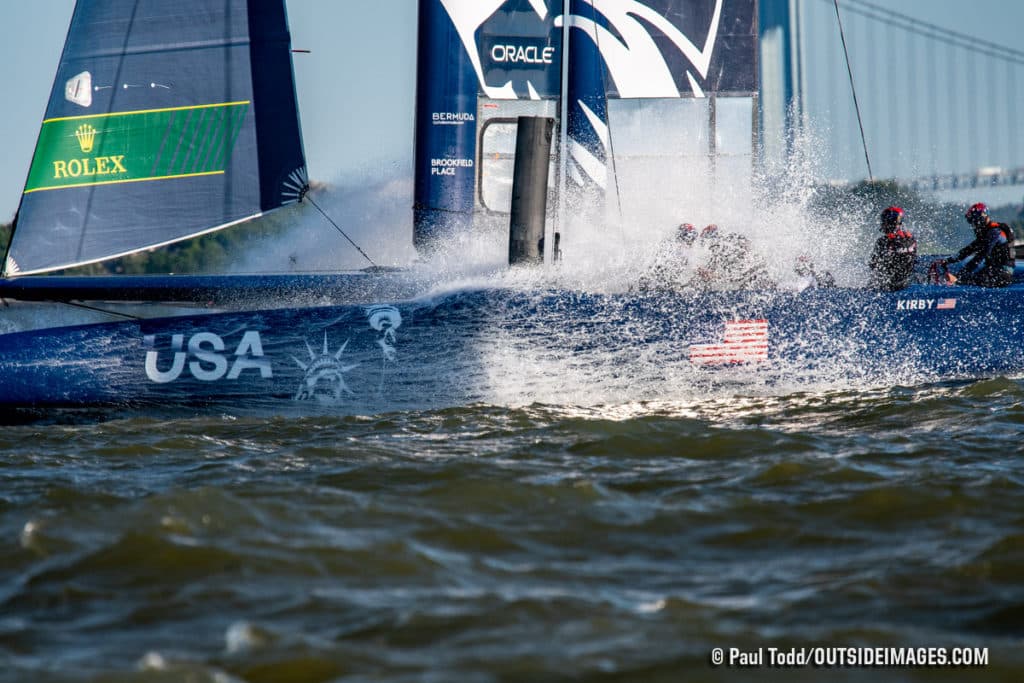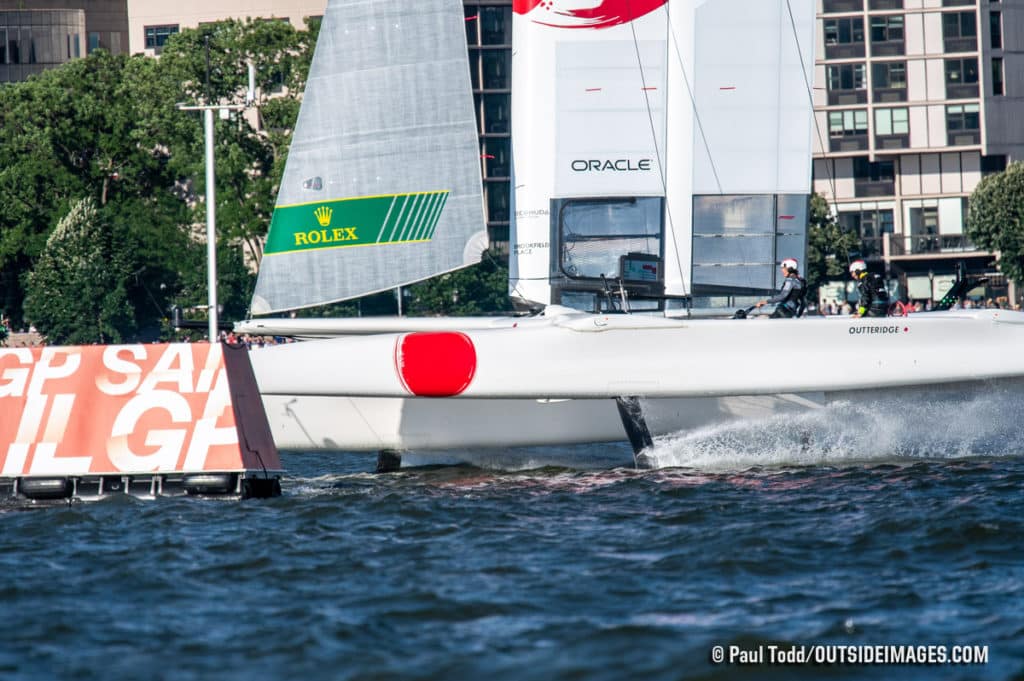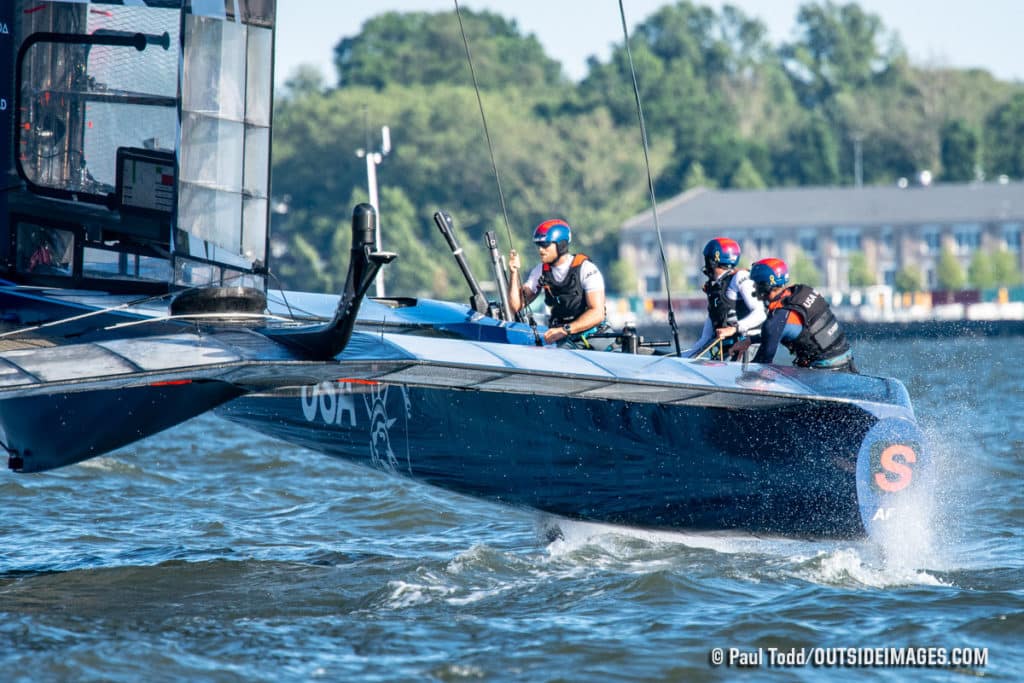
Great Britain SailGP skipper Dylan Fletcher never saw it coming, the 37-knot gust that made his team the first casualty of SailGP’s wild first day of racing on the Hudson River. Only moments before, the British team had taken a break from its warmup laps to hydrate and reset. It was all good, Fletcher says. “We were managing it well and were saying to ourselves that the key was to keep everyone in one piece, the boat in one piece and someone isn’t going to finish the day.”
Famous last words, right?
“We returned to doing our normal practice routine and were heading to the leeward gate when we got hit by the gust,” says Fletcher. “It came pretty quick.”
The boat capsized swiftly, and once all crew were accounted for, the boat was righted with obvious damage to upper panels of the wing, forcing them to return to their mooring and watch the day’s three races from the sidelines.
Meanwhile, the United States SailGP team was dealing with its own breakdown; not with the boat, but with wing trimmer Ryley Gibb’s back. Twenty minutes before the first race, says skipper Rome Kirby, the team was scrambling for a substitution. With backup wing trimmer Tom Johnson in Europe, they called in their shore team manager Jeff Causey.
“He’s never sailed on the boat and he’s never trimmed the wing,” Kirby says.
On the F50s, a wing trimmer in sync with his helmsman and flight controller is critical and there was no hiding that all the American team could do was sail every race, keep the wing pointed to the sky and minimize points on the scoreboard: even if it was messy.
Compromised as they were, the U.S. team won the first start, crossing the line with pace and position, but lost control of the boat, soon after. “It is frustrating,” Kirby says, “especially coming off San Francisco. We are going well and had a couple good days of practice. We won the start, but got too high, which is a combination of wing trim and popping the rudder out. It’s tough when you never sail with your wing trimmer, but Jeff did a nice job and kept the boat upright…we got around the track. We can come back tomorrow and that’s what I care about. We’ll just keep battling.”
Johnson, a teammate of Kirby from his America’s Cup days in Bermuda with Oracle Team USA, is said to be arriving in the morning, well before Saturday’s 5:00 start. “We’ll be good and come out firing,” Kirby says. “I can tell you that.”

“We had one going in to the bottom mark and we were doing around 49 knots with both hulls in the water. I was trying to slow the boat down, raking the boards forward to try and keep it in the water.” —Tom Slingsby

With two of six teams compromised before the racing even started, the SailGP series returned to form, as it did in San Francisco, with Team Japan and Team Australia going toe-to-toe off the start. When it was all said and done, there was no denying the supremacy of the two teams, especially the one with the red and white hulls.
Team Japan lead the first two legs of the first race before giving it to the Australian’s on the first upwind leg. “The wind shadow was right in the middle of the track so we tried to take the left [side of the course],” says Team Japan skipper Nathan Outteridge. “We just fell out of the breeze. We were a long way ahead and basically stopped and the Aussies came around us on the right, so it was clear from there on we had to go up the Manhattan side. It definitely cost us the race going the wrong way.”
With that bit of racecourse knowledge, and a touch more confidence in their boathandling, Team Japan put on a clinic, dominating the remaining two races with spectacular foiling tacks.
“We sailed well in the second race, but we were not tacking at the level we needed to, so in the last race Ian [Jensen] and Luke [Parkinson] were into me saying, ‘just turn it a bit quicker,’” Outteridge says, “so that gave me the confidence they were ready for it and I was just whipping it through the tacks. It’s quite cool what you can do with these boats. We did a few foiling tacks in the last race and it’s always a huge gain.”
Outteridge and all other skippers, however, were keenly aware of the British capsize and the need to be cautious. “We had great training laps and when the British capsized we toned it down a bit,” Outteridge says. “Then we had to really amp it back up a bit because we sailed too conservatively in the first race. I’m impressed with how well we did, everyone on the boat had a go today, the skills of the Japanese guys, their intuition and reading of the wind is awesome.”
The day’s takeaway, Outteridge adds, was confidence in themselves and their boathandling. “If we do everything right with the flight control, wing trim and driving we can do anything we want with the boat,” he says. “Today, coming out I wasn’t really confident racing was possible, but at the end we were racing it much harder than we were at the beginning. Without a doubt, it’s scary out here in such small spaces, especially at the top mark where we’re bearing way at 35 knots heading straight into the spectator fleet knowing we have to jibe. I’m used it by now, but I can see how it can be terrifying to some of the guys that don’t have the confidence in the boat or themselves.”
While it appeared Team Australia was struggling at times to maintain consistent straight-line speed, it had more to do with the unpredictable wind streaks and lulls across the racecourse. “We didn’t sail ideal, but we’re happy to get through the racing,” says Team Australia skipper Tom Slingsby. “There were times when Team Japan were there to attack and we put our foot down, but there were times they were far ahead and we just made sure we got second place. We’re happy with what we got and only 1 point down.”
Even with strong winds in the forecast, all teams used light-air foils, which also contributed to difficult handling at times. The decision to use larger foils, Slingsby says, was for the ability to foil sooner in the light-air spots. “We had 30 knots and 3 knots, so there was no right answer,” he says, “but there were some big puffs. We had one going in to the bottom mark and we were doing around 49 knots with both hulls in the water. I was trying to slow the boat down, raking the boards forward to try and keep it in the water. I was worried we were going to capsize in the turn up. I’ve never been that quick with two hulls in the water, that’s for sure.”
The Australian’s survived the day, but Slingsby was also concerned for his wing trimmer Jason Waterhouse, who is dealing with back issues of his own. “Jason’s back is just like Riley’s; it’s very temperamental and can go out any time. As soon as we saw what happened with them, I went to Jason and asked him if he was all good—he has no idea when it’s going to go out. We’re always very nervous for Jason’s back.”
Racing resumes on Saturday afternoon at 5:00 PM EST, with two fleet races and the winner-take-all match-race final. More over at www.sailgp.com









